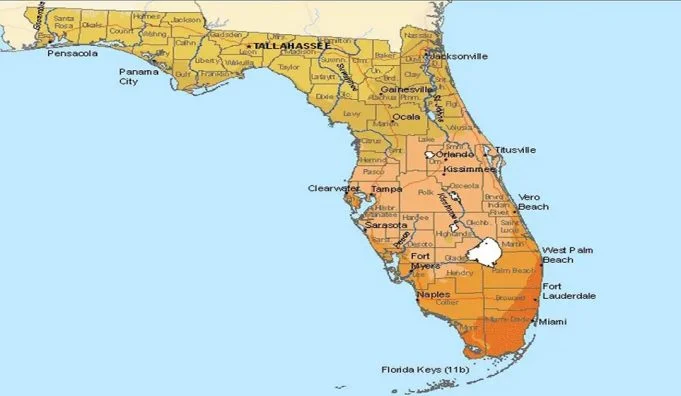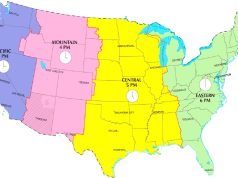The majority of Florida’s Time Zone is located in the Eastern Time Zone, while its northwest border is in the Central Time Zone. Miami-dade, Quincy, Tallahassee, Crawfordville, Jacksonville, Lake City, Gainesville, Daytona Beach, Orlando, Tampa, Fort Myers, and Key West are included in the Eastern Standard Time Zone.
Pensacola, Panama City, Marianna, Chipley, Defuniak Springs, Valparaiso, Fort Walton Beach, and Crestview belong to the Central Standard Time Zone. Summertime time zones in Florida use Daylight Saving Time.
The majority of regions currently observe Eastern Daylight Time, while the northwest point observes Central Daylight Time.
What is a Time Zone?
The Time Zone is a geographical world globe division of 15o each, beginning at Greenwich, England, designed to assist people in determining what time it is in another part of the world.
Occasionally, individuals in not-so-distant locations require the same time as those in not-so-distant locations, so the division is now much more political than geographic. In addition, we have Daylight Savings Time, which is also a Time Zone variation, in order to save energy.
Typically, your country’s government or an astronomical institute defines time zones, which are represented by three or four letters. Section 3.2 contains examples.
The History of Time Zone
Prior to the advent of trains and aircraft, the majority of communities set their clocks based on what made the most sense given their location. If the sun rises at 7 a.m., a town may determine that it is 7 a.m. Another municipality may determine that sunrise occurs at 7:30 a.m. A third town may concur that sunrise occurs at 7:30 a.m., but due to their location, the sunrise did not occur at the same time as the other town. It was extremely perplexing.
In the United States, there were over 144 local times by the early 1880s! Incorporating the various seasons, clock variations, and other variables, the situation was chaotic.
This confusion was of little consequence when everyone traveled on foot or horseback. Upon entering a new municipality, you would simply adjust your watch. However, with the advent of train travel, it became apparent that action was required.
In 1883, the nation’s main railroads collaborated to establish four standard time zones. This helped them coordinate train schedules, and eventually, everyone adopted this system. The United States government officially adopted these time zones in 1918.
How Do Time Zones Work?
There are four time zones in the continental United States: Eastern, Central, Mountain, and Pacific. Alaska and Hawaii also have distinct time zones.
Each of the Eastern, Central, Mountain, and Pacific time zones is separated by one hour. Due to the fact that the sun rises in the east, the Eastern time zone is always the latest during the day. Thus, eight a.m. in the Eastern time zone corresponds to seven a.m. in the Central time zone, six a.m. in the Mountain time zone, and five a.m. in the Pacific time zone. Hawaii would be at 3 a.m. while Alaska would be at 4 a.m.
Here is another example:
If the big game begins at 5 p.m. in the Central time zone, but you reside in the Eastern time zone, add one hour and switch on your television at 6 p.m. EST. Subtract two hours if you reside in the Pacific time zone and begin viewing at 3 p.m. PST.
What is The Florida Time Zone?
Florida consists of two time zones. All of the main cities, including Jacksonville, Miami, Tampa, and Orlando, are located in the Eastern Time zone. Depending on the season, there are two distinct clocks due to daylight savings time.
- Eastern Standard Time(EST) : – 5:00 UTC/GMT (behind)
- Eastern Daylight Time(EDT) : – 4:00 UTC/GMT (behind)
About 17% of Florida is in the Central Time Zone, which includes the ten westernmost counties. Additionally, they observe daylight savings, so there are two distinct timepieces depending on the season.
- Central Standard Time(CST) : – 6:00 UTC/GMT (behind)
- Central Daylight Time(CDT) : – 5:00 UTC/GMT (behind)
Florida observes dual time zones, but the time is synchronized with neighboring states. This implies you do not need to adjust your watch when entering Georgia (Eastern Time) or Alabama (Central Time). You will remain in the same time zone permanently.
Florida Daylight Savings Time (DST)
Florida observes daylight saving time in accordance with the Uniform Time Act of 1966. It is less effective than in other states due to the relatively modest natural seasonal variation in day length between summer and winter.
During daylight savings, Standard time is replaced by Daylight time, so CST becomes CDT and EST becomes EDT, depending on location. The total duration of daylight savings is 34 weeks or approximately 65 percent of the year.
It begins the second Sunday of March and concludes the first Sunday of November. In March, the clock is advanced from 2:00 am to 3:00 am, resulting in a loss of one hour of slumber. In November, the time will be set back an hour, from 3:00 a.m. to 2:00 a.m., giving you an extra hour of sleep. Clocks “spring forward and fall back” is a convenient method to remember the movement sequence.
Benefits of Daylight Saving Time
The greatest advantage of permanent daylight saving time would be the elimination of slumber disruptions. There is no need to change the time twice a year before, at, or after 2 a.m. on a Sunday in the autumn and spring.
In addition, you would have more time during the day to be active, and it would be better for your health because there would be no sleep disruptions. There is no need to modify your bedtime or morning routines.
There are Two Time Zones in Florida
Florida observes two standard time zones: Eastern Time (ET) and Central Time (CT). The eastern and southern regions of Florida observe Eastern Daylight Time (EDT) during Daylight Saving Time (DST).
Only 10 municipalities in the Panhandle region of northern and western Florida observe Central Standard Time (CST) and Central Daylight Time (CDT).
Gulf County, located in the Florida Panhandle, observes both Eastern and Central Time. The southern component of the county, where the largest city, Port St. Joe, is located, observes Eastern Time, while the northern portion, Wewahitchka, observes Central Time.
How was Florida Historically Divided?
Let’s first examine how time zones were established. In 1883, a civil engineer came up with the concept of time zones in order to assist train schedules. With the passage of the Standard Time Act in 1918, the United States adopted standard time zones and daylight saving time.
Beginning at the Georgia border and proceeding south along the Apalachicola River, the Florida timeline was established. Unlike the river, the timeline does not extend all the way to the coast.
The shipping and railroad industries desired to retain the coastal areas in the Eastern Time Zone, so the line bends at the Apalachicola River’s fork in Apalachicola and encompasses Post St. Joe and all the communities and beach towns to the south.
Frequently Asked Questions (FAQs)
Why is it called time zone?
A time zone is a region that observes the same standard time for legal, commercial, and social purposes. Instead of rigorously following longitude, time zones tend to follow the borders between countries and their subdivisions because it is more convenient for areas with frequent communication to observe the same time.
What is Florida’s time in GMT?
The eastern portion of Florida, including all of its main cities, falls within the Eastern Time Zone, which is five hours behind Greenwich Mean Time (GMT-5). The western portion of the Florida panhandle is located within the Central Time Zone. Which is six hours behind Greenwich Mean Time (GMT-6).
Is Florida in 2 time zones?
There are two time zones in Florida. The western portion of Florida (the panhandle south of Alabama) observes Central Time (UTC 6 hours), while the remainder of the peninsula observes Eastern Time (UTC 5 hours).
Is Florida time zone EST or EDT?
The majority of Florida is located within the Eastern Time Zone (UTC05:00, DST UTC04:00).
Is Florida in standard time?
The eastern and southern regions of Florida observe Eastern Daylight Time (EDT) during Daylight Saving Time (DST). Only 10 municipalities in the Panhandle region of northern and western Florida observe Central Standard Time (CST) and Central Daylight Time (CDT).
How long is Florida in hours?
From north to south, Florida can be traversed in 8 hours and 30 minutes, but allot 12 hours for the 540-mile trip from Georgia to Key West due to traffic. It takes only 2 hours and 20 minutes to travel from east to west across Florida.
How many time zones does the United States have?
With the Fall 2019 release of the National Transportation Atlas Database (NTAD), a new map of the nation’s time zones is included, depicting the geographical boundaries of four time zones in the continental United States and five additional time zones used in Alaska, Hawaii, and other U.S. territories.
Where is the time change in Florida?
Gulf County is the only Florida county with two time zones. Gulf County includes Mexico Beach, Port St. Joe, Wewahitchka, and Apalachicola as cities close to the time zone. When Florida residents cross the Apalachicola River, they enter a distinct time zone.
How to calculate the time zone?
To determine the appropriate time zone in hours, the longitude, in degrees, must be divided by 15. For instance: At a longitude of 150 degrees west (or 150° W), the time should be 150 degrees divided by 15 degrees, or UTC-10.























![25 Best Peruvian Foods You Must Try In Peru [With Recipes] Peruvian Food](https://tourinplanet.com/wp-content/uploads/2024/07/Peruvian-Food-100x75.jpg)



![What is The Marvelous VFR C500? – [Key Features and Overview] Marvelous VFR c500](https://tourinplanet.com/wp-content/uploads/2024/07/Marvelous-VFR-c500-100x75.jpg)
